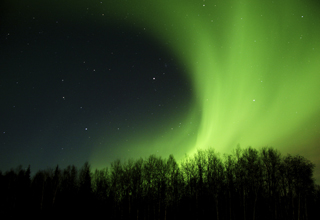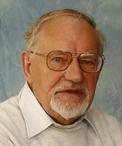Northern Lights
Interview with Professor George Rowland, Department of Physics
Published August 2010
 The forecasters have got better at predicting the weather. They still get it wrong however, to our annoyance. Unfortunately there are too many variables affecting weather to ensure completely accurate predictions, especially more than one or two days in advance but, complicating matters further, weather is also chaotic.
The forecasters have got better at predicting the weather. They still get it wrong however, to our annoyance. Unfortunately there are too many variables affecting weather to ensure completely accurate predictions, especially more than one or two days in advance but, complicating matters further, weather is also chaotic.
This is a technical term used to describe systems that are incredibly sensitive to initial conditions. In principle we should be able to work out what the weather will do next week based on what the situation is today. However, make one tiny change to today’s situation and next week’s weather could turn out completely different. By ‘tiny’, I mean extraordinarily tiny. This idea has been best understood as 'The Butterfly Effect' - a butterfly flaps its wings in Europe and creates a storm in America. Prof George Rowlands, of the University of Warwick Physics Department, explains: “Chaos comes out of equations where a tiny error in the initial conditions propagates out like an explosion.”
Weather in outer space is similarly chaotic, as those who are burdened with the task of forecasting know. It is not rain that they watch out for, however, but plasma showers. The sun expels particles continuously, some of which travel in our direction, and arrive at earth 3 days later. “They are like hot little bullets. They cause havoc for the commercial satellites that orbit earth; they destroy the radio transmitters so when plasma storms are coming the equipment needs to be turned off and protected - just like when you turn off the TV when lightening is about.”
It is technically complicated to predict the timing and density of these storms. The stream leaving the sun very soon becomes turbulent, which is another technical term used to describe complicated situations. A modern way physicists have come to understand turbulent phenomena relies on fractal theory. Fractal theory supposes that a very complicated situation arises from a very simple process happening again and again. If we imagine a trunk that grows two stalks. Each stalk then behaves like a trunk and grows two more stalks. Soon a many-branched tree results. The challenge therefore is to work out what simple rule governs the plasma streams.
It is in fact the very same particles that are responsible for the Northern Lights. As the particles rips through our atmosphere light is produced; when enough particles make this journey together the phenomenon of the aurorae occurs. But that does not explain why the light only appears in the far north: “When the plasma stream approaches earth it is diverted around the earth by the magnetic field. As they are diverted all hell breaks loose, it is very chaotic. The same phenomenon occurs at the southern tip as well, it's just there is no one there to witness it.” In fact any planet with a magnetic field will have their own version of the Northern Lights: “When I saw the image of Jupiter’s Northern Lights I was very impressed.”
Although Prof Rowlands is aware of these applications of his work, as a theoretical physicist, he is specifically interested in modelling the behaviour of plasma mathematically: “Fundamentally we would like to know what is happening in the sun. The only way we can find out is to observe - we cannot send anyone in. In recent years there have been some fantastic satellite pictures. It is literally erupting like a volcano and throwing out these particles everywhere.”
 George Rowland is a professor in the Department of Physics at Warwick. His research interests include theories of non-linear and chaotic systems. In 2001 he was awarded a Leverhulme Emeritus Fellowship. In 2006 he was awarded the Andrzeja Sottana Medal for distinguished research with the theory group of the Sottan Institute for Nuclear Studies in Poland. Prof Rowlands is the only non-Polish recipient ever to have been honoured in this manner.
George Rowland is a professor in the Department of Physics at Warwick. His research interests include theories of non-linear and chaotic systems. In 2001 he was awarded a Leverhulme Emeritus Fellowship. In 2006 he was awarded the Andrzeja Sottana Medal for distinguished research with the theory group of the Sottan Institute for Nuclear Studies in Poland. Prof Rowlands is the only non-Polish recipient ever to have been honoured in this manner.
